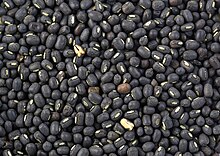Urd Bean
| Urd Bean | ||||||||||||
|---|---|---|---|---|---|---|---|---|---|---|---|---|

Urd Bean ( Vigna mungo ) |
||||||||||||
| Systematics | ||||||||||||
|
||||||||||||
| Scientific name | ||||||||||||
| Vigna mungo | ||||||||||||
| ( L. ) Hepper |
The black gram ( Vigna mungo ), also lens bean called, is a species of the subfamily of the Pea family within the family of legumes (Fabaceae or Leguminosae). This crop is closely related to a number of other crops called " beans " , in particular the mung bean ( Vigna radiata ).
history
The ancient bean has been cultivated on the Indian subcontinent for 3,000 to 4,000 years and is now widespread throughout South and Southeast Asia.
description
The cultivated plant Urdbohne grows as a low, upright or hanging annual plant . This was selected from wild forms that grow as perennial herbaceous plants with 2 to 4 m long stems. Depending on the variety, the cultivated plants usually reach heights of only 20 to 30 cm, they can also be 60 to 90 cm.
The hairy leaves are tripartite and petiolate. The leaf stalks have lengths of about 10 cm. The three broadly lanceolate to pointed oval leaves are 5 to 7 cm wide and 5 to 10 cm long.
The axillary on about 15 cm long inflorescence stalks, usually two to three times branched inflorescences, contain partial inflorescences, each containing five to six flowers. The flower color is bright yellow. Each flower only blooms for a few hours. Mostly self-pollination takes place.
Usually only two to three legumes develop per partial inflorescence. The rough hairy, straight legumes are 4 to 7 cm long and about 0.6 cm wide. Each pod contains four to ten seeds. The shiny, small, square seeds with rounded ends have a diameter of about 4 mm. The color of the seeds is usually very dark green to black, which is why they are called "Black gram"; there are also green forms. The seeds are white inside, which is a clear differentiator from the mung bean, which is yellow inside. The white, concave hilum has a length of 1.2 to 2.3 mm and a width of up to 1 mm. The thousand grain weight is 15 to 40 grams. The seeds germinate epigeously (above ground).
use
You can use the fresh pods, the bean sprouts or the dried beans. In India, the ancient bean is one of the most popular beans. Because of the same cooking time, it can be combined well with rice. In South India, a batter made from it is the basis for the savory breakfast donuts ( Vada ), and together with rice flour for dumplings ( Idli ) and pancakes ( Dosa ). It can also be used in place of lentils in papadam shops. The ancient bean has a relatively high protein content of around 20 to 24% (of dry weight).
Systematics
It was first published as Phaseolus mungo in 1767 in Mantissa Altera , 1, 101 by Carl von Linné . The currently valid name was published in 1956 by Frank Nigel Hepper in Kew Bull. 11,128. Synonyms of Vigna mungo (L.) Hepper are: Azukia mungo (L.) Masamune , Phaseolus radiatus Roxb. non L. , Phaseolus roxburghii Wight & Arnott . It should be noted that Phaseolus radiatus L. is a synonym for Vigna radiata and Phaseolus radiatus Roxb. is a synonym of Vigna mungo .
Vigna radiata belongs to the subgenus Ceratotropis in the genus Vigna .
There are two varieties:
- The cultivated form Vigna mungo (L.) Hepper var. Mungo (Syn .: Phaseolus mungo L. (Basionym), Phaseolus viridissimus Ten. Ex Miq. , Nom. Inval.)
- A wild form Vigna mungo (L.) Hepper var. Silvestris Lukoki et al.
Web links
- SI Ali: Papilionaceae in the Flora of Pakistan : Vigna mungo - Online.
- Walter H. Schuster, Joachim Alkämper, Richard Marquard & Adolf Stählin: Legumes for grain use: Grain legumes of the world , Justus Liebig University Gießen, 1998 .: Joachim Alkämper: Information on the Urdbohne ( Vigna mungo ). (German)
- Entry at GRIN.
- Data sheet.
Individual evidence
- ^ A b Vigna radiata in Germplasm Resources Information Network (GRIN), USDA , ARS , National Genetic Resources Program. National Germplasm Resources Laboratory, Beltsville, Maryland.
